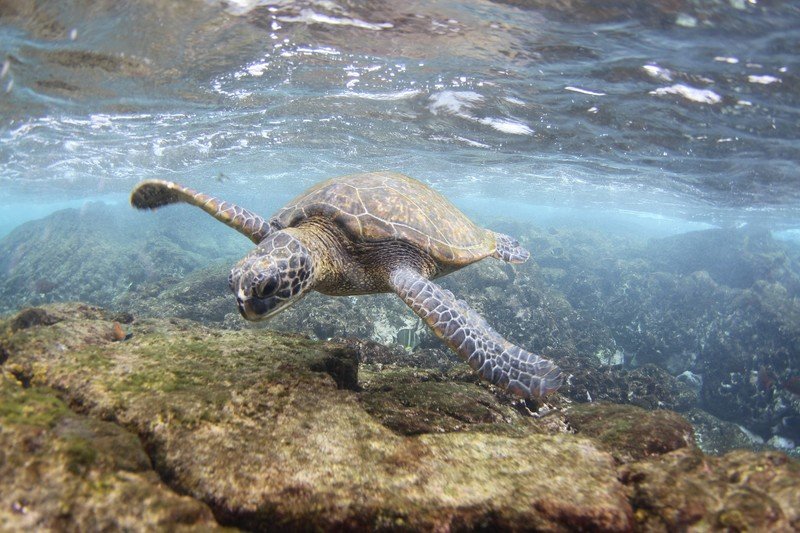Critical Habitat Protection Proposed for Green Sea Turtles Including Florida & Hawai’i Nesting Beaches and Offshore Habitat
PETERSBURG, FL—In response to a legal agreement with environmental groups, the U.S. Fish and Wildlife Service and NOAA Fisheries today proposed to designate roughly 8,850 acres of beaches and nearly 428,000 square miles of coastal waters as protected critical habitat for six distinct populations of green sea turtles.
“I’m relieved that green sea turtles are on their way to getting the habitat protection they need. These graceful marine turtles have come a long way. Still, healthy habitats will be key to their survival,” said Stelise Bennett, Florida and Caribbean director at the Center for Biological Diversity. “The global climate crisis and sea-level rise are already harming these turtles’ nesting and feeding areas, and we can expect those threats to get worse. These ancient reptiles are legally entitled to our help, and the federal government needs to give it to them.”
For Atlantic green sea turtles, the proposed critical habitat on land includes approximately 5,725 acres of nesting beaches in Florida, where green sea turtle nesting activity in the U.S. is greatest, 250 acres in Puerto Rico, and 117 acres in Vieques and the U.S. Virgin Islands. The proposed marine critical habitat includes nearshore waters up to 20 meters deep around all of Florida, parts of Puerto Rico, and parts of the U.S. Virgin Islands, areas the turtles use for reproduction, migration, foraging, and resting. It also includes sargassum habitat in the Gulf of Mexico and the Atlantic Ocean.
For Pacific green sea turtles, the proposed terrestrial habitat includes approximately 2,233 acres of nesting and basking beaches in the main Hawai‘ian Islands, 95 acres in the northwestern Hawai‘ian Islands, 242 acres in American Samoa, 125 acres in Guam, and 179 acres in the Northern Mariana Islands. The proposed marine habitat includes nearshore waters off Hawai‘i, American Samoa, Guam, and the Mariana Islands.
“I’m hopeful protected habitat will help give green sea turtles a bright future,” said Maxx Phillips, Hawai‘i director, and staff attorney at the Center. “The turtle’s fragile nesting grounds need to be treated with care if the species is going to survive. In a warming climate, we don’t have any time to lose. Federal habitat protection for the turtle is overdue, but I’m glad it’s coming soon.”
The proposed habitat protections fulfill a court-ordered agreement secured by the Center for Biological Diversity, Sea Turtle Oversight Protection (STOP), and Turtle Island Restoration Network as a result of a federal lawsuit filed in 2020. The Fish and Wildlife Service and NOAA Fisheries had previously determined that growing climate change and threats from sea level rise meant the turtles still needed Endangered Species Act protection. Despite recognizing those threats — particularly to low-lying nesting beaches — the agencies failed to protect the turtle’s critical habitat under the Act.
A 2019 peer-reviewed study by Center scientists found that most marine species listed under the Endangered Species Act are recovering. Listed species with critical habitat protections, and those listed for more than 20 years, are most likely to be rebounding. The Endangered Species Act prohibits federal agencies from authorizing activities that will destroy or harm a listed species’ critical habitat.
“Today’s action gives green sea turtles a fighting chance at surviving rising seas caused by climate disruption and devastating pollution from plastics and offshore oil drilling,” said Joanie Steinhaus, Turtle Island Restoration Network’s director of oceans. “It is unfortunate it took a lawsuit to get this life raft for endangered sea turtles — beginning with our lawsuit challenging the lack of action under the former Trump administration.”
Federal experts have found that green sea turtles should be considered 11 distinct populations or distinct population segments. Although some sea turtle populations, like those in Florida, are improving significantly due to the Endangered Species Act’s protections, several populations continue to struggle. The Mediterranean, Central South Pacific, and Central West Pacific populations remain in danger of extinction and remain listed as endangered.
The Fish and Wildlife Service and NOAA Fisheries are holding public hearings and informational meetings. The agencies are accepting comments on the critical habitat proposals at www.regulations.gov through October 17, 2023.
The Center for Biological Diversity is a national, nonprofit conservation organization with more than 1.7 million members and online activists dedicated to protecting endangered species and wild places.
Turtle Island Restoration Network is a global nonprofit whose mission is to inspire and mobilize people around the world to protect marine biodiversity and the oceans that sustain all life on Earth.
.




